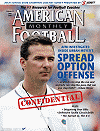AMERICAN FOOTBALL MONTHLY THE #1 RESOURCE FOR FOOTBALL COACHES
Article CategoriesAFM Magazine
|
Defensive Line Attack: Read Rules for 6 Offensive Line Stepsby: Dennis Truitt© More from this issue This article will focus on the reads for an attacking style defensive front. These reads are based on the idea of offensive linemen being able to take 6 initial steps that will tell the defensive lineman how to react. The reactions are based on whether the defensive player lines up in an inside shoulder technique (a 7 tech for example) or an outside shoulder technique (a 5 tech for example). The reads and techniques are the same for both outside and inside shoulder reads. The only difference is the blocker being read. If aligned as an outside shoulder player, the defender reads the blocker he is lined up on. If aligned as an inside shoulder player, the defender reads the first blocker inside from the blocker he is lined up on (See Diagrams 1A and 1B). Subscribe today!
|
|
|||||||
| HOME |
MAGAZINE |
SUBSCRIBE | ONLINE COLUMNISTS | COACHING VIDEOS |
Copyright 2025, AmericanFootballMonthly.com
All Rights Reserved





